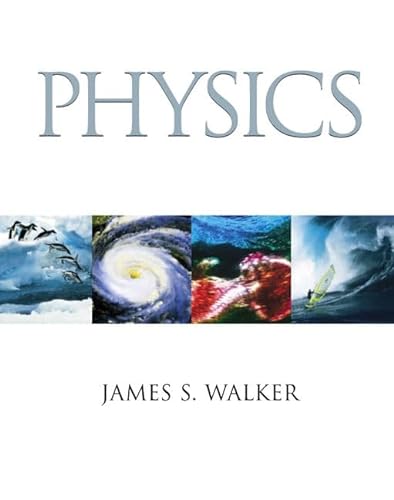Items related to Physics

Synopsis
Physics is designed to give readers conceptual insight and create active involvement in the learning process. The book provides a suite of pedagogical tools that give readers an active role in the learning and problem-solving process. This comprehensive book helps readers draw the situation described in the problem statement, visualize the processes taking place, identify and label important quantities, and set up coordinate axes. Shows readers how to analyze the problem, identify the key physical principles at work, and devise a plan for obtaining the solution. Contains a unique 2-column format. Appropriate for readers interested in Algebra-based Physics.
"synopsis" may belong to another edition of this title.
About the Author
James S. Walker obtained his Ph.D. in theoretical physics from the University of Washington in 1978. He subsequently served as a post-doc at the University of Pennsylvania, the Massachusetts Institute of Technology, and the University of California at San Diego before joining the physics faculty at Washington State University in 1983. Professor Walker's research interests include statistical mechanics, critical phenomena, and chaos. His many publications on the application of renormalization-group theory to systems ranging from absorbed mono-layers to binary-fluid mixtures have appeared in Physical Review, Physical Review Letters, Physica, and a host of other publications. He has also participated in observations on the summit of Mauna Kea, looking for evidence of extra-solar planets.
Jim Walker likes to work with students at all levels, from judging elementary school science fairs to writing research papers with graduate students, and has taught introductory physics for many years. His enjoyment of this course and his empathy for students have earned him a reputation as an innovative, enthusiastic, and effective teacher. Jim's educational publications include "Reappearing Phases" (Scientific American, May 1987) as well as articles in the American Journal of Physics and The Physics Teacher. In recognition of his contributions to the teaching of physics, Jim was recently named Boeing Distinguished Professor of Science and Mathematics Education.
When he is not writing, conducting research, teaching, or developing new classroom demonstrations and pedagogical materials, Jim enjoys amateur astronomy, bird watching, photography, juggling, unicycling, boogie boarding, and kayaking. He recently spent three weeks rafting through the Grand Canyon and hiking in various side canyons. Jim is also an avid jazz pianist and organist. He has served as ballpark organist for several Class A minor league baseball teams, including minor. league affiliates of the Seattle Mariners and San Francisco Giants.
From the Back Cover
Physics is designed to give readers conceptual insight and create active involvement in the learning process. The book provides a suite of pedagogical tools that give readers an active role in the learning and problem-solving process. This comprehensive book helps readers draw the situation described in the problem statement, visualize the processes taking place, identify and label important quantities, and set up coordinate axes. Shows readers how to analyze the problem, identify the key physical principles at work, and devise a plan for obtaining the solution. Contains a unique 2-column format. Appropriate for readers interested in Algebra-based Physics.
"About this title" may belong to another edition of this title.
FREE shipping within U.S.A.
Destination, rates & speedsSearch results for Physics
Physics
Seller: ThriftBooks-Atlanta, AUSTELL, GA, U.S.A.
Hardcover. Condition: Very Good. No Jacket. May have limited writing in cover pages. Pages are unmarked. ~ ThriftBooks: Read More, Spend Less. Seller Inventory # G0136331246I4N00
Quantity: 1 available
Physics
Seller: ThriftBooks-Atlanta, AUSTELL, GA, U.S.A.
Hardcover. Condition: Good. No Jacket. Pages can have notes/highlighting. Spine may show signs of wear. ~ ThriftBooks: Read More, Spend Less 5.85. Seller Inventory # G0136331246I3N00
Quantity: 1 available
Physics
Seller: ThriftBooks-Dallas, Dallas, TX, U.S.A.
Hardcover. Condition: Good. No Jacket. Pages can have notes/highlighting. Spine may show signs of wear. ~ ThriftBooks: Read More, Spend Less 5.85. Seller Inventory # G0136331246I3N00
Quantity: 1 available
Physics
Seller: Toscana Books, AUSTIN, TX, U.S.A.
Hardcover. Condition: new. Excellent Condition.Excels in customer satisfaction, prompt replies, and quality checks. Seller Inventory # Scanned0136331246
Quantity: 1 available
Physics
Seller: Georgia Book Company, CHICKAMAUGA, GA, U.S.A.
Hardcover. Condition: As New. WHITE COVER LIKE NEW - NEVER ISSUED-MAY HAVE SCHOOL STAMP, NUMBER, MINIMAL SHELF WEAR - EXPERIENCE AMAZING CUSTOMER SERVICE - WE SHIP DAILY. Seller Inventory # SKU002115
Quantity: 1 available
Physics
Seller: PAPER CAVALIER UK, London, United Kingdom
Condition: very good. Gently used. May include previous owner's signature or bookplate on the front endpaper, sticker on back and/or remainder mark on text block. Seller Inventory # 9780136331247-3
Quantity: 1 available

